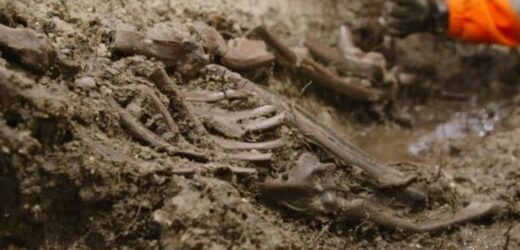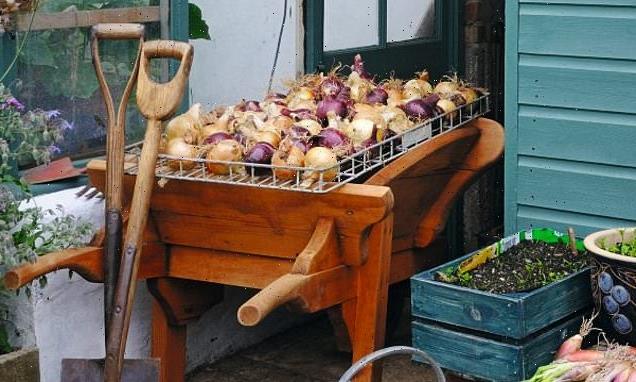Digging for Britain: Professor Alice Roberts looks at Roman busts
We use your sign-up to provide content in ways you’ve consented to and to improve our understanding of you. This may include adverts from us and 3rd parties based on our understanding. You can unsubscribe at any time. More info
Archaeologists working at St Mary’s Church, Stoke Mandeville could not have imagined the treasure trove of artefacts that would meet them when they first set to work on the site. The site sits right on the line of the planned HS2 route, and dates back to 1080AD. St Mary’s Church sits around one kilometre outside Stoke Mandeville, and fell into disrepair in 1880 when a new church was built closer to the village. The Royal Engineers were drafted in to pull it down in January 1966.
Archaeological excavations first began on the site four years ago in preparation for the construction of the HS2 railway.
The process involved moving the remains of around 3,000 people buried in the churchyard.
Further discoveries have shed more light on the history of this fascinating site.
The archaeological excavation was featured in the recent BBC documentary ‘Digging for Britain’.
Archaeologists, led by Dr Rachel Wood, announced the discovery of remains on the site of the church.


They had discovered a square foundation trench, enclosed by a circular ditch containing burials, three remarkable life-sized Roman busts and a series of other artefacts.
Dr Wood said of the discoveries: “You can’t even say it’s a once in a career [discovery].
“It’s ‘you would be extremely lucky if you ever found anything like that’, never mind two or three of them.”
The BBC camera crew joined the analysis of the artefacts once the dig had been completed.
Among the discoveries analysed were a bizarre skeleton, the busts, cremation urns and a very well-preserved glass jug.

The skeleton was found headless in the circular ditch.
Professor Alice Roberts, the programme’s presenter, said the “extraordinary” skeleton had leg injuries “which suggest a sudden, violent end”.
She said: “It’s all beyond the archaeologists’ wildest expectations.”
The body was found near funerary urns that had been thrown into the ditch and broken apart.
Guy Hunt, another archaeologist working at the site, said: “There are eight of them.
DON’T MISS:
Scientists discover new approach to beat antibiotic-resistant bacteria [NEW]
Archaeologists stunned by Ancient Greek device: ‘Rethink history’ [QUOTES]
Archaeology: Coin discovery could ‘rewrite idea of London’s history’ [INSIGHT]

“And we also have an inhumation. That inhumation is really interesting because it’s not someone who’s buried in a classic way.
“It’s someone that’s more or less been rolled into a ditch.
“They were buried with some coins, and the coins are actually a really key thing here.”
The coins can be dated, giving archaeologists a much better idea of when the various items were deposited in the ditch.
Mr Hunt suggested the busts and cremation urns might have been “violently destroyed” when they were dumped in the ditch.

He said: “We don’t want to over-interpret, right. But I think that looks like deliberate destruction of it into this ditch.”
Dr Wood added: “Certainly the cremation urns have been thrown into that ditch with no care.”
The urns were filled over with rubble. Prof Roberts suggested two possible reasons for this: moving things out of the way at the site, perhaps to build an Anglo-Saxon tower, or alternatively it represents the destruction of a set of beliefs that were no longer operating.
Mr Hunt said: “Yeah, and that’s why the coins are important, because when we get a date for the destruction moment, we will be able to say different things about it.
“So if it’s happening in the late Roman period, then I think that has a different meaning than if it was happening in the 6th or 7th Century.”
Archaeologists working on the HS2 route are digging up new things on an almost daily basis. In the last week alone, a vast wealthy Roman trading settlement has been found in south Northamptonshire.
They believe an Iron Age village, first established in about 400 BC, had more than 30 roundhouses which then developed into a wealthy Roman trading town.
They discovered a 10 metre wide Roman road, labelled “exceptional in its size”, running right through the site.
Meanwhile, an extremely rare, carved wooden figure from the early Roman era was found in a waterlogged ditch in Buckinghamshire, also on the HS2 route.
A 67cm tall figure carved from a single piece of wood was described as “incredible” and “brings us face to face with our past”.
More than 1,000 archaeologists have been working on at least 60 separate sites along the HS2 phase one route between London and Birmingham since September 2018.
Source: Read Full Article


